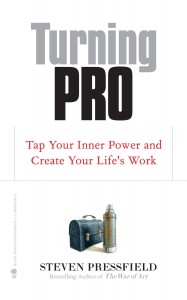“The amateur tweets. The pro works.”
That’s one of my favorite quotes from Stephen Pressfield’s Turning Pro. It is the only two sentences in a chapter titled, “The Professional Will Not Be Distracted.”
For writers, social media can either be a distraction or an opportunity to share our work. We have to make this important distinction. The decision to open your Twitter client, head to Facebook, or post an image on Instagram can have two possible motivations:
- Avoid the work.
- Share the work.
How do you know the difference? How can you know what your motivation is?
Two other quotes from from Turning Pro:
“The amateur craves third-party validation.”
“The professional self-validates.”
Ask yourself: Am I doing this work for its own sake or creating something in order to receive validation?
Social media is tempting. It’s so easy to get caught up in the responses we get to putting ourselves out there. If we’re not careful, we can let likes, tweets, favorites, and shares dictate our art.
We can fool ourselves into thinking our social media marketing is productive, but often it’s just an excuse to avoid our real work. We’re all guilty of doing anything we can other than opening up that manuscript and getting to work. The long, hard work of writing a book is often rewardless and seemingly impossible. Social media, on the other hand, offers immediate gratification (or dissatisfaction).
Don’t let that happen. Focus on your art first and sharing it second. That’s what Steven Pressfield would say.
I stand by my conclusion in this social media metrics article: focus on ideas first and the response second. I’m better off ignoring the engagement metrics altogether in order to create more art.
Do Your Work and Share it Too
Austin Kleon‘s book, Show Your Work, is convincing me that social media could be an opportunity to not to avoid our work, but to show our work.
A part of his argument is that as artists all we have to do is share a little piece of our art, our inspiration, or research, or work with the world every day. That’s how we get discovered. That’s how people who are allergic to marketing can build a following.
I love this approach because it reassures the artist to focus on the art first and the response second. If we focus on the response first, we’ll never create the art. The fear of rejection would hold us back.
Conclusions
I thought, when I started this series on social media for authors, that I would come up with a group of tools and systems to help me and other writers use social media effectively. In fact, I already created a cheat sheet for myself with seven types of social media posts for authors that I’ve been using (and with good results).
What I’m realizing, though, is that the reason to use social media as an author is so much more than post likes and shares. It’s not so much about the tactics and strategies that really matter. Tactics do get extra likes and shares, but they can easily be distractions from our real work, our true callings.
As authors, we’re in it for the long-term. It’s about a career, a body of work, not a vanishing tweet or Facebook post.
As artists, we can’t afford to sacrifice the long-term success for the short-term gain.
Here is my next step:
Before I can weave together that list of strategies and tactics and procedures and habits, I am going to come up with a list of principles–rules to place upon myself so that I use social media as an extension of my work, my ideas, and my art and not a distraction from it.



